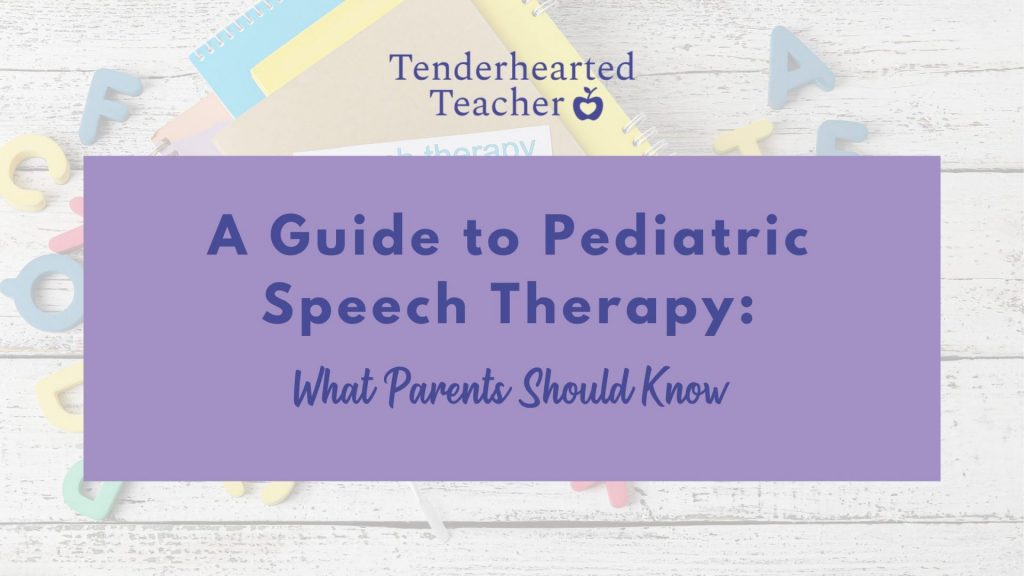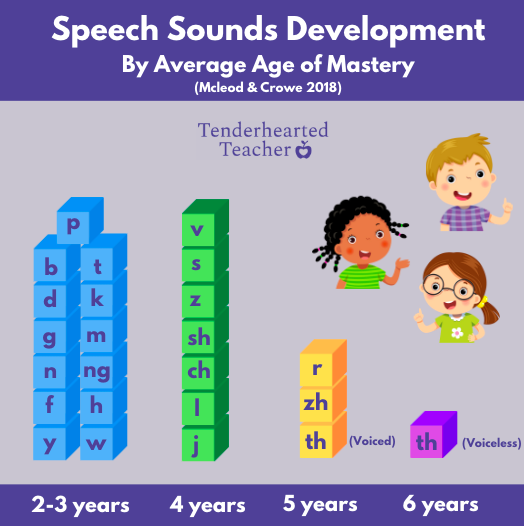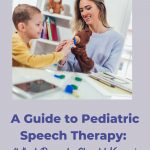
This is the second installment of my “Guide to Related Services” series. With these posts, I will share information regarding the resources available to toddlers and preschoolers who aren’t meeting their developmental milestones. The first post was about occupational therapy. You can read it here. This time, I’ve spoken to a certified speech-language pathologist about the ins and outs of pediatric speech therapy as well as ways to help your child’s development at home.
What is Pediatric Speech Therapy?
Before diving into the specifics of therapy, it’s important to know the difference between speech and language. According to the American Speech-Language-Hearing Association (ASHA), speech is how we say sounds and words. Language is the words we use and how we use them to share ideas and get what we want. Additionally, the organization states:
“We can have trouble with speech, language, or both. Having trouble understanding what others say is a receptive language disorder. Having problems sharing our thoughts, ideas, and feelings is an expressive language disorder. It is possible to have both a receptive and an expressive language problem. When we have trouble saying sounds, stutter when we speak, or have voice problems, we have a speech disorder.”
ASHA
Pediatric speech therapy is provided to individuals under the age of 18 who have difficulties with speech and/or language. Speech-language pathologists (SLPs) provide therapies for these issues and can work with patients in homes, schools, and clinical settings/hospitals.
Amanda Sargenti, M.S., CCC-SLP, informed me that pediatric speech therapy targets receptive, expressive, and pragmatic language disorders or deficits. It also targets articulation, phonological processes, oral motor, voice, and fluency disorders as well as auditory processing disorders. SLPs can also address feeding and swallowing issues.
Why Might A Child Need Pediatric Speech Therapy?
Now that we know what pediatric speech therapy entails, Sargenti explains when it may be necessary.
“In regards to language development, parents should be aware of developmental milestones for comprehension, spoken language, play, and attention. Toddlers and preschoolers should be able to demonstrate appropriate play skills, answer simple yes/no questions as well as increasingly complex “wh” questions, begin to tell simple stories, and develop a command of conversational rules.”
With that said, she has shared some developmental red flags parents should look out for. An evaluation may be warranted if your child is struggling to:
- Make eye contact
- Establish joint attention
- Follow directions with and without gestural cues
- Answer simple yes/no questions
- Use words more than gestures to communicate for a variety of pragmatic functions
- Show mastery of age-appropriate sounds (see image below for reference.)

What Can Parents Expect During An Evaluation?
According to Sargenti, the first step in an evaluation is a thorough parent interview. Then it is followed by standardized testing and a functional assessment. By the end of the evaluation session, the speech therapist typically informs the parents of whether or not services are warranted, their initial impressions, and the goals to be targeted. A comprehensive written report is then completed with the information gathered during the evaluation.
A therapy schedule is determined if the child qualifies. During their sessions, the child works 1-on-1 with the clinician for a set period of time on their individualized goals. Most early language skills are targeted through play. Later developing skills can be targeted in trials and in play. Individualized goals are continuously revised to encourage carryover to all settings.
Ways Parents Can Support Their Child’s Development At Home
Sargenti has shared some of the most common tips she provides to her families. These strategies can be used at home to help support your child’s speech and language development.
1. Engage in Play
Not only is your child using their imagination and developing important social-emotional skills through play, but they are also honing their speech and language skills. For example, during play, your child learns new words and routines, how to take turns, how to establish joint attention, and follow directions (i.e. “kick the ball over there” or “roll the ball down the ramp.”) Click here to read more about the stages and types of play.
2. Use Your Surroundings and Routines to Encourage Learning
Environments in and out of your home are ripe with language learning opportunities. For example, if you and your child are in the grocery store, you can have them categorize different food items like fruits vs. vegetables. You can also play “I Spy” games. Additionally, you should encourage your child to be an active participant during errands. For instance, allow them to help you prepare the grocery list and provide them with opportunities to recall items once in the store.
Another great way to encourage language is by talking about your daily schedule and routines. It’s important to use narrative words such as first, next, then, after, and last. “First, we’re going to get dressed. Then, we will put on our shoes.”
Finally, let your child make predictions about your activities and plans. “What do you think we’ll see at the zoo today?” Afterward, review their predictions and talk about whether they were right!
3. Read Books Daily
Books are fantastic tools for speech, language, and vocabulary development. Ideally, you should read to your child every day. While you’re reading together, make sure to label and describe the pictures/illustrations throughout the books. In addition, allow your child to read to you too (even if they are making up their own story!) Finally, use phrases like “I see a __” and “he is jumping” to encourage syntax development. For more reading tips, please download my free literacy guide below.

4. Sing Songs and Encourage Imitation
Imitation is another way children learn new sounds and vocabulary. Environmental noises and animal sounds are a great place to start to target imitation skills. For example, caregivers should use environmental sounds like “vroom”, “choo choo” or “ready, set, go!” when playing with toy cars and trains. Songs like “The Wheels on the Bus” and “We All Go Traveling By” encourage imitation as well.
5. Practice Good Vocal Hygiene
Parents and caregivers should remind their children that too much yelling can hurt their vocal folds so it’s important to use inside voices when appropriate. In addition, they should model positive communication skills such as using proper rate, rhythm, and vocal hygiene. Finally, they should teach their child that drinking water helps keep vocal folds healthy and hydrated.
To Wrap It Up
Sargenti notes that there are some sounds that are age-appropriate for children not to make accurately in early childhood. And some dysfluencies such as using “like” or “um” are typical as a child’s language develops and can be seen during moments of planning complex thoughts.
Even if parents don’t have all of this information, she still believes they know their children best. Therefore, she advises caregivers to “trust their gut” and discuss any concerns they may have with their pediatrician. Another option is to reach out to their local school district to inquire about the evaluation process.
Finally, when asked, “what is one thing you wish parents knew about speech therapy?” she stated, “we are here to help you and your family and not critique your parenting or choices! It is only natural to be nervous prior to an evaluation, but we strive to make you as comfortable as possible and to also teach you skills and techniques to use at home. Speech therapy can only help your child by providing them with a language-rich environment to grow and learn.”
Now talk to me! Did you learn something new today about pediatric speech therapy? Tell me in the comments below!
SAVE TO PINTEREST





I loved how you pointed out that speech therapy can only benefit your child by giving them a linguistically diverse environment in which to develop and learn. This advice will undoubtedly be useful to my sister, whose two-year-old boy speaks inappropriately for his age. I will advise her to contact an early intervention agency after she said the other day that she wants to find out and treat whether her son is truly experiencing speech delay issues.
Thank you for sharing the information